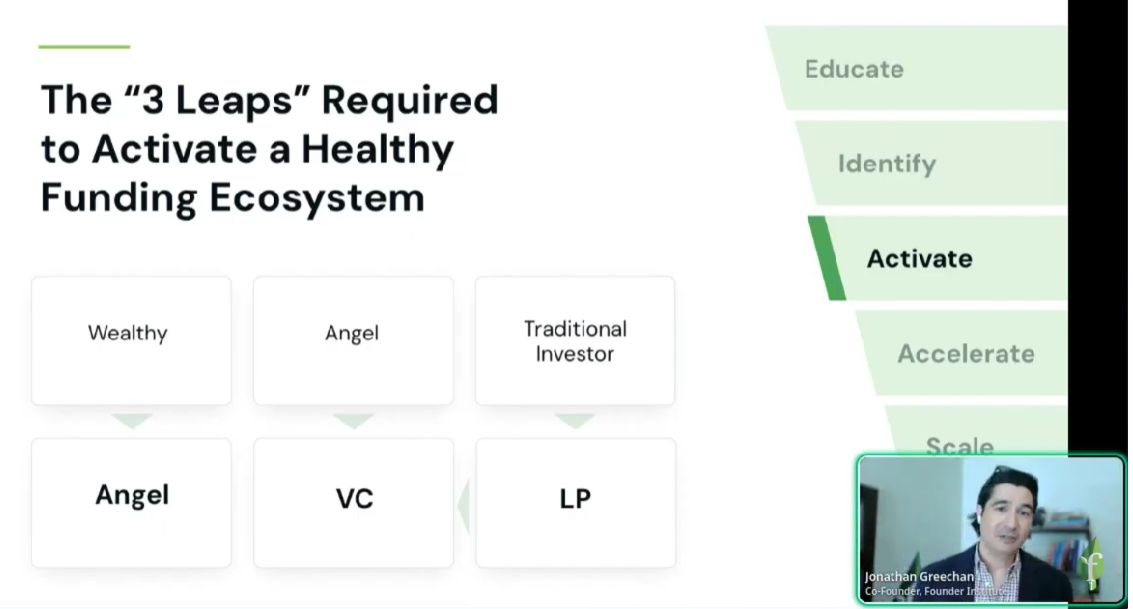
One of the significant hurdles of running a startup is to find and collaborate with the right people. It can be industry experts who can help you build the right things, mentors who can guide you, or potential clients who will be happy to sign up for your product.
In this syndicated post, Daria Erina, Managing Director of Linked Helper. will help you guide you through the best startup networking practices for taking advantage of scaled automation in LinkedIn.
Daria joined Linked Helper soon after the project was born, and became the first customer support agent. She’s on a mission to make the Linked Helper’s solution feel like a piece of cake to new and existing customers, specifically by creating high-quality content.
Why LinkedIn Outreach Matters for Startups
No matter the reason for outreach, you need a channel where you can connect to relevant people effectively. While attending trade shows or communicating with people in specialized forums work, they are not as effective as a professional social network.
Hence, LinkedIn is one of the best options to build and manage your network.
There are three benefits that you get with LinkedIn:
-
Trust: When doing outreach over LinkedIn, your contacts are less likely to consider your message as something spammy or shady as they can see your profile and validate that they are talking to a trustworthy person.
-
Enhanced filtering: LinkedIn allows you to filter people based on their experience, profession, location, and more. So, you can find and reach out to your target audience with little hassle.
-
Scalability with little loss of communication quality: By using InMail or specialized LinkedIn automation tools, you can do mass outreach while sending a personalized message to each of your contacts.
Considering the many benefits of LinkedIn, it’s not a surprise that it has become the favorite platform of many startup founders.
The Challenges of Manual Outreach
Reaching out to important contacts over LinkedIn is a highly well-performing process. With the example of SEO outreach, you can get up to a 25% response rate compared to the mere 8.5% of emails.
It is, however, a highly challenging process. Some of the common problems you can encounter include:
-
Resource-heaviness: Can you imagine the time it will take to manually research hundreds of contacts, draft a personalized message for each, and send them? Yes, the response rate will be high. But the time you spend on it will not be worth it.
-
Messy communication: Now, imagine some of the hundreds of prospects have answered your message, others have ignored and require a follow-up, while the third group has asked you questions. With manual outreach, the process of managing the communication lifecycle of each prospect quickly becomes a mess.
-
Eventual low conversion rate: Although your response rates will be high, the messy management of the rest of communication will soon result in late answers and ignored messages - significantly dropping your conversion rate.
Lucky for us, there are ways to keep the high engagement rate of personalized communication while scaling your outreach. One of the most common solutions for this is using a specialized LinkedIn automation tool.
Selecting the Right Automation Methods
There are several ways you can automate a LinkedIn outreach, including both internal and 3rd party tools. But first, we need to understand how to pick the tool that fits your needs the best.
Let’s begin with the criteria for choosing a tool:
-
User interface: There are intuitive and more complex tools. Your pick will depend on your savviness.
-
Compliance: LinkedIn comes with a set of rate limits and rules that the tool of your choice needs to follow. Make sure to check this. Otherwise, your profile might earn a ban.
-
Personalization: Depending on the tool, you might have different levels of personalization you can have in your outreach messages. Some limit with name and location, while others can mention the target's posts or comments.
-
Analytics: You will benefit from the analysis of your outreach campaigns and the metrics that the automation tool can track. So check the analytics features of the tool before picking it.
Apart from these general criteria, there are also certain features that you would benefit from having in the automation tool. Here are a couple of examples.
Personalized messages: This feature lets you add variables into a template that will personalize the messages sent to each individual.
Drip Campaigns: This is a sequence of messages that the tools send automatically based on certain user behavior such as them not responding to the initial message and the drip feature sending a follow-up after a week.
Source: Linked Helper
Data Export and Import: With these features, you can export the communication and campaign data into a spreadsheet for further analysis or import data from a different tool.
To sum up, there are many amazing tools for you to automate your LinkedIn outreach. The best option for you specifically depends on which features and aspects of these tools you consider the most important.
Crafting Your Outreach Strategy
Choosing the right tool is important, but it’s only a small part of a successful campaign. A more significant aspect that you should pay attention to is your outreach strategy.
By working with many LinkedIn outreach experts and hearing their opinions, we have crafted a short list of steps for building a highly effective campaign:
-
Set your goals: The success of any campaign starts with a clear goal. Try to understand and formulate what you want from the campaign. Is it beta users that will help you test your MVP? Or is it your early adopters that will ensure the initial inflow of revenue for your product?
-
Identify target audience: Based on your goal, start describing the people you want to target. Beta users, for instance, would be people working in your industry and complaining about the problems you can solve with your MVP in their LinkedIn posts.
-
Use effective messaging techniques: Take advantage of messaging best practices and tactics such as the RRR (relevant, relatable, respectful) and value-driven messaging. The latter is about emphasizing the value your prospects get from your product in your messages.
-
Set up automation sequences: Based on the techniques we mentioned, you can start drafting your messages and creating a chain drip campaign out of it. A great drip campaign has a message for every kind of user response to the initial message (e.g. ignored, asked a question, showed interest, etc.).
-
Measure and iterate: Send your first round of messages to prospects, use the analytics feature of your tool to measure key metrics such as open and engagement rates, and then try a different variation of your campaign to see if it performs better.
The real-life outreach campaign will consist of more steps than the 5 we mentioned. But these 5 are the must-haves no matter the goal or the nature of your campaign.
Compliance and Best Practices
Automating your LinkedIn outreach is great, of course. However, you need to be careful with this process for two reasons. The first is compliance. You don’t want LinkedIn to think there’s a spam bot messaging people and block you. The second is, well, not being spammy with your contacts.
So, let us help you understand the limits and policies of LinkedIn and share a couple of handy tips with you on how to avoid spammy behavior.
LinkedIn provides all 3rd party automation providers with quotas. If you’re using a custom solution for automation, you will find information about these quotas in your LinkedIn developer dashboard.
Source: LinkedIn API Guide
Usually, these quotas are very large and the chances of you depleting them are low. But, it is still a good idea to keep an eye on them.
If you’re using a SaaS automation tool, however, you don’t have to worry about these quotas as the tool itself will help you avoid sending too many messages.
Now, regarding the best practices of messaging in bulk. Here are a couple we have compiled based on our extensive experience with LinkedIn automation:
-
Limit the number of connection requests to somewhere around 100 per day.
-
Make sure that your campaigns don’t accidentally send the same message twice to contacts. Otherwise, there’s a risk of your contacts marking you as spam.
-
The message you send should add value to the recipient. This way, you will significantly lower the risks of them considering your connection requests as a spammy one.
In general, our advice is to find a balance between quantity and quality. You should spend your time crafting good personalized messages instead of sending something generic to a large audience.
Measuring Success and Scaling Further
It is relatively easy to increase the number of people you contact on LinkedIn per campaign. However, doing so without any prior analytics is bad practice.
As mentioned in the previous section, you risk sending generic content to your contacts and earning yourself spam reports. However, that is not the only reason you should analyze your campaigns before scaling them.
Another important reason is the effectiveness of your campaigns.
No matter how well you plan and craft a campaign, if you’re sending it to a certain audience for the first time, it is very likely to perform worse than expected. The reason is that your original plan is based on your assumptions of what your contacts want.
But, as soon as you send your first batch and analyze the results, you find out that some parts of your understanding were wrong and your campaign requires improvements before scaling it.
For this, we suggest you track and measure the following metrics:
Connection Acceptance Rate: It is the percentage of people who have accepted your connection. You can calculate this metric using the formula below.
Alternatively, you can use the built-in analytics suite of your automation tool to track this without manual calculation.
Response Rate: The percentage of people who have responded to your message. The formula is similar to that of the Connection Acceptance Rate. The only difference is that here, you’re dividing the number of responses by the number of messages sent.
Again, automation tools have this one built in too.
Qualified Leads: This metric is relevant if the goal of your outreach is sales. This is the number of people who have shown interest in your product and are likely to buy it.
Conclusion and Next Steps
Building a strong network is among the most important parts of running a startup. You always need early adopters, potential investors, and mentors.
LinkedIn is a great platform for this task, and the abundance of automation options makes it easy for you to scale your outreach efforts without compromising the quality of the communication with your contacts.
So, use the best practices we have shared with you here to continuously improve your outreach campaigns and get the most out of LinkedIn networking.
The Founder Institute is the world’s most proven network to turn ideas into fundable startups, and startups into global businesses. Since 2009, our highly-structured accelerator programs have helped entrepreneurs raised over 1.9BN in funding across over 200 cities worldwide.
Learn more about the Founder Institute at FI.co, join an upcoming startup event at FI.co/events, or subscribe to our Insights Newsletter.



